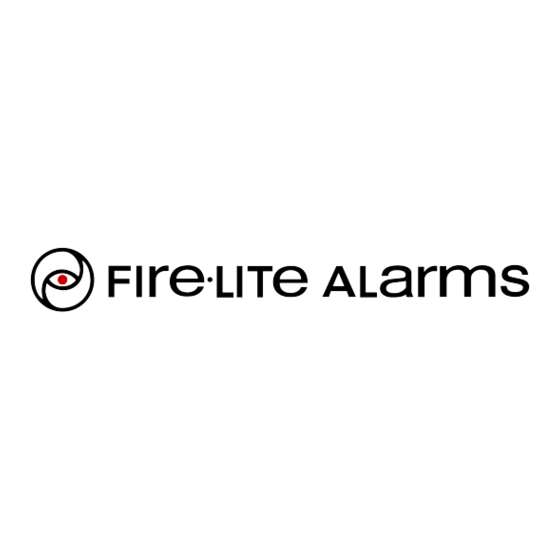Advertisement
Quick Links
INSTALLATION AND MAINTENANCE INSTRUCTIONS
I300-6 Six Fault Isolator Module
SPECIFICATIONS
Normal Operating Voltage:
Stand-By Current:
Maximum Current Draw:
Temperature Range:
Humidity:
Dimensions:
Accessories:
Wire Gauge:
BEFORE INSTALLING
If the modules will be installed in an existing operational system, inform the
operator and local authority that the system will be temporarily out of service.
Disconnect the power to the control panel before installing the modules. This
system contains static sensitive components. Always ground yourself with a
proper wrist strap before handling any circuits so that static charges are re-
moved from the body. The housing cabinet should be metallic and suitably
grounded.
NOTICE: This manual should be left with the owner/user of this equipment.
GENERAL DESCRIPTION
The I300-6 Six Fault Isolator Module provides six equivalent circuits that will
allow a portion of the communications loop to continue operating when a
short circuit occurs on that loop. An amber LED indicator will blink in the
noromal state for each of the six inputs and will latch on during a short circuit
condition. The module will automatically restore the communications loop to
normal condition when the short circuit is removed.
CONTENTS INCLUDE:
(6) 1 × 4 Terminal Blocks
(2) 1¼˝ (32mm) Stand offs
(4) Machine Screws
(2) Nuts
COMPATIBILITY REQUIREMENTS
To ensure proper operation, this module shall be connected to a compatible
FireLite system control panel.
COMPONENTS
Following are descriptions of the I300-6 mounting frameworks. There are two
mounting options for I300-6 modules:
• Up to six I300-6 modules can be installed on a CHS-6 in a CAB-3, CAB-4
or BB-25 cabinet
• One or two I300-6 modules can be installed in a BB-XP cabinet
Chassis
The CHS-6 chassis is used to mount I300-6 modules in a BB-25, CAB-3 or
CAB-4 Series cabinet. It accommodates up to six I300-6 modules in a single
cabinet row three modules wide and two modules deep.
15-32VDC
2.7 mA
102 mA
32°F to 120°F (0°C to 49°C)
10 to 93% Non-condensing
6.8˝H × 5.8˝W × 1.0˝D
CHS-6 Chassis; BB-25 Cabinet; BB-XP Cabinet; CAB-3 Series Cabinets; CAB-4 Series Cabinets
12-18 AWG
FIGURE 1. CHS-6 CHASSIS:
The BB-XP cabinet has a built-in chassis that will accommodate one or two
I300-6 modules.
FIGURE 2. BB-XP CABINET:
The front I300-6 module positions of each chassis are offset below the rear
I300-6 module positions so that all of the status indicators are visible.
Cabinets
A BB-25, CAB-3 or CAB-4 Series cabinet will house the CHS-6 chassis with up
to six I300-6 modules installed on it. Refer to cabinet installation documents
for dimensions.
The BB-XP cabinet houses one or two I300-6 modules on the internal chassis
that is part of the cabinet. Refer to cabinet installation documents for dimen-
sions.
1
One FireLite Place
Northford, CT 06472
Phone: 203.484.7161
MOUNT WITH
SELF-THREADING SCREWS
TO BACK OF CABINET
I56-4097-000
C0236-01
C0234-06
Advertisement

Summary of Contents for Fire-Lite Alarms I300-6
- Page 1 Following are descriptions of the I300-6 mounting frameworks. There are two mounting options for I300-6 modules: • Up to six I300-6 modules can be installed on a CHS-6 in a CAB-3, CAB-4 or BB-25 cabinet • One or two I300-6 modules can be installed in a BB-XP cabinet...
- Page 2 INSTALLATION STEPS Step 1: Insert the bottom of the I300-6 module down into a rear slot on the 1. Cabinet Mounting chassis. In a clean, dry area, mount the backbox using the four holes provided in the Step 2: Carefully pivot the upper edge of the board back towards the back of back surface of the cabinet.
- Page 3 Step 1: Insert the bottom edge of the I300-6 module down into a front slot of the chassis.
- Page 4 FCC STATEMENT This device complies with part 15 of the FCC Rules. Operation is subject to the following two conditions: (1) This device may not cause harmful interference, and (2) this device must accept any interference received, including interference that may cause undesired operation. NOTE: This equipment has been tested and found to comply with the limits for a Class B digital device, pursuant to Part 15 of the FCC Rules.



Need help?
Do you have a question about the I300-6 and is the answer not in the manual?
Questions and answers